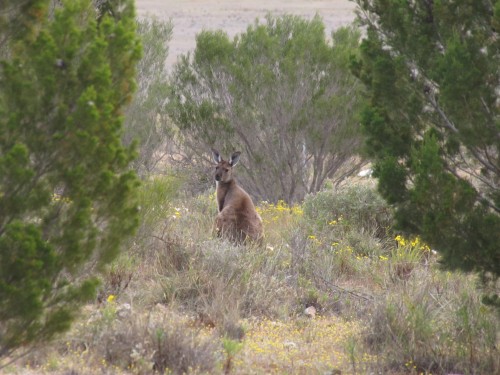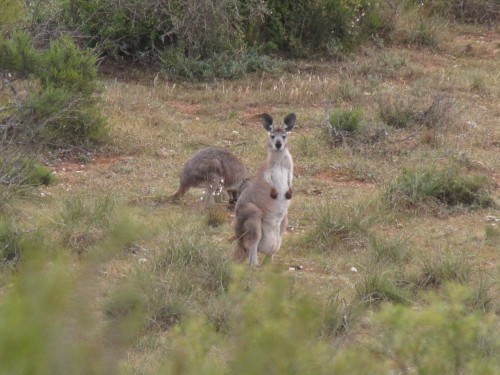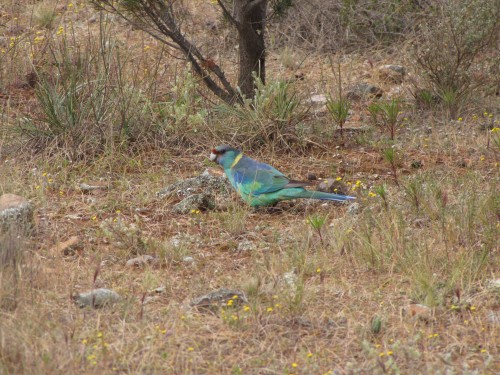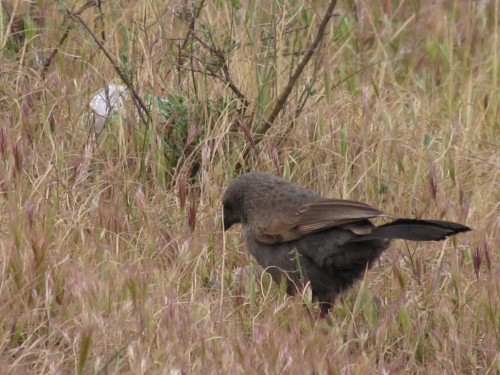Wildlife in the Greg Duggan Nature Reserve
Kangaroos
The wildlife in the Greg Duggan Nature Reserve in Peterborough, South Australia is quite diverse. Over recent weeks I have been sharing some of the wildflowers I photographed there in September last year. Despite being only 10 acres in size, the fauna is also quite interesting as well. When I visited a small mob of Western Grey Kangaroos was grazing contentedly on the grasses thriving in the park. The female in the photo below looks decidedly like there is a joey in her pouch.
Introduced Mammals
While I didn’t see any other mammals on this visit apart from several rabbits there are sure to be also a few other introduced mammals in this reserve and nearby, including:
- Red Fox (common)
- Brown Hare (common)
- House Mouse (common)
- Black Rat
- Feral House Cat (widespread)
- Goat (present in large numbers further north in the Flinders Ranges)
- Fallow Deer (small feral populations in nearby Jamestown area)
Native Mammals
- Western Grey Kangaroo (common)
- Echidna (probably present in this area)
- Several Bat species (common)
- Brushtail Possum (possibly present)
Reptiles:
I am no expert in this field but there are many species of reptiles in the wildlife of this area, including:
- Snakes – the common species would be Brown Snakes, but there must be others
- Lizards – many species including Blue-tongues, Stumpy-tailed, geckos, skinks and so on
Insects:
Again, I am no expert in this field but I have casually observed a variety of
- butterflies (see photo below – I haven’t been able to identify this one)
- moths
- grasshoppers
- many kinds of beetles, bugs and native cockroaches, to name only a few.
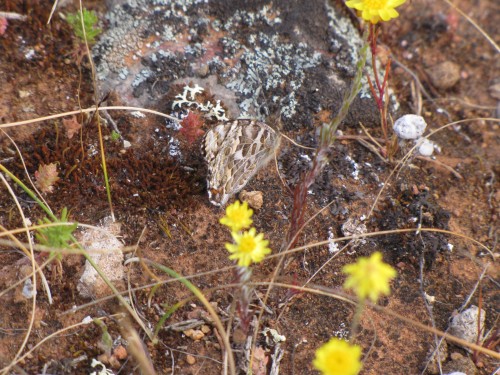
Butterfly or moth? (Hard to see – it is right in the middle of the photo just above the two flowers)
Birds:
This is one area of wildlife where I do have a great deal of knowledge in this area. In all, there are probably well over 150 different species of birds in the region – say, within a 20km radius. Included in this list are a few waterbirds (present in dams and a wetland area near the caravan park), eagles, hawks, pigeons, many species of honeyeaters, chats, babblers, parrots, thornbills, magpies, ravens, woodswallows, finches and the list goes on.
I have included only two photos today (see below). Of special note is the Apostlebird, an uncommon species in South Australia. The township of Peterborough has several large family groups of this species and is one of only a handful of places in the state where they can be reliably seen. The are very common in the eastern states, however.
Red Lory parrots, Taronga Zoo, Sydney
The Red Lory shown in these photos is part of the collection of exotic birds kept in Taronga Zoo in Sydney. I’ve never seen this species in its natural habitat because they are endemic to the Indonesian islands of the Moluccas and nearby islands. It certainly would be a stunning bird to see in it natural environment. The Wikipedia article says it is a popular aviary bird and I can well imagine that its bright colours being very attractive to collectors and bird admirers.
The bird shown here was photographed in a walk through aviary at Taronga Zoo in Sydney.
Rainbow Lorikeets, Taronga Zoo, Sydney
During our visit to Taronga Zoo in Sydney we found a quiet picnic area so we could eat our lunch. Most visitors to the zoo take advantage of the various restaurants and other food outlets, but we would rather bring our own picnic lunch. We found a lovely grassed area with a few picnic tables and enjoyed a pleasant lunch.
At a table nearby some overseas visitors were enjoying the company of two Rainbow Lorikeets. They had provided some food for the birds who were happily devouring the free meal. While this provided me with a great photo opportunity, I can’t condone the action of these visitors. Human food is never good for our native birds so I would discourage all of my readers to refrain from feeding our birds.
Polly wants a penny – or a dollar
The Free Flight Bird Show at Taronga Zoo in Sydney has been my topic here for quite a few days now. Whenever we visit the zoo we make sure we schedule one of the shows into our schedule. It is also a great opportunity to get some good photos of the birds.
At the end of each show the keepers invite audience members to come forward and give some of the parrots a donation of a coin. The birds accept the coin in their beak and immediately drop it into the donation box. In this way over $75,000 has been raised for bird conservation in recent years. Today’s photo features one of those birds, a Sulphur-crested Cockatoo which is a common bird in the Sydney region. It is also common in other parts of Australia too.
Long-billed Black-cockatoo, Taronga Zoo, Sydney
The Long-billed Black-cockatoo is also known as Baudin’s Cockatoo. In its natural habitat it is confined to the south western corner of Western Australia. I have seen this species on only a handful of occasions on my last visit to that state. Sadly, this was in 1978, so we are well overdue for a return visit to the beautiful state of Western Australia.
The next best thing is to view these beautiful birds in a zoo – surely a very poor second, but still good. On our visit to Taronga Zoo in Sydney last year we eagerly watched the Free Flight Bird Show, a twice daily introduction by the keepers to the birds of Australia. These cockatoos were on display after the show so that visitors could get a good, close up view of them. It also provided me with an excellent photo opportunity.
